
 THE
HEALTH OF THE MALTESE POPULATION
THE
HEALTH OF THE MALTESE POPULATIONHomepage maintained by C. Savona-Ventura
| Home |
| Maltese
Epidemiological Information |
| Maltese
Medical History |
| Maltese Medical Links |
Epidemiology of Abnormalities: Specific Mortality Trends
Mortality statistics can be used to identify possible trends of certain obvious severe lethal abnormalities, though these figures must be tempered by the fact that the actual reporting of birth defects may vary considerably by differences in definition and terminology over the years. Published mortality data by cause of death is available in Malta since May 1872 in the form of fortnightly reports published by the Chief Police Physician and annual reports after 1896 published by the Chief Government Medical Officer. Interpretations of mortality trends are difficult since cause-specific mortality is dependant on a correct diagnosis of the cause of death, while the small numbers involved in Malta result in wide annual fluctuations. Cause-specific mortality rates for the Maltese Islands are available, though detailed breakdown by specific causes is unavailable for certain years [1]. The mortality rates from congenital malformations during the late nineteenth and twentieth century are shown in Figure 1.
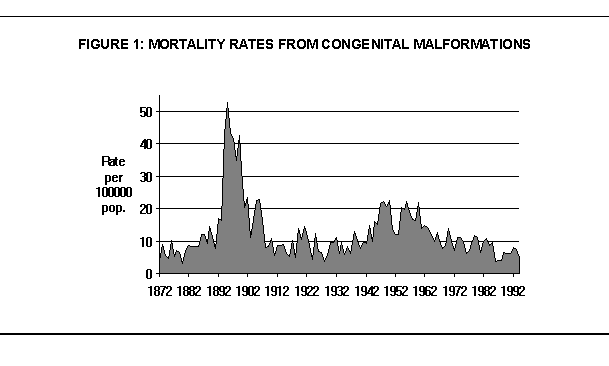
The registered lethal congenital malformations in the Maltese Islands during 1873 amounted to 13 cases, accounting for an anomalies-specific mortality rate of 9.0 per 100,000 population or 30.2 per 10,000 births. The mean overall specific mortality rate for the decade 1873-1882 was 6.8 per 100,000 population. This figure was a definite underestimation resulting from misdiagnosis and misregistration as to cause of death. This is evidenced by the fact that during this decade the majority (83.8%) of lethal congenital malformations were neural tube defects (hydrocephalus, spina bifida, anencephaly). The other specified malformations for the same period included ano-rectal atresias (6 cases: 6.1%) and facial clefting (5 cases: 5.1%) [2]. This trend was apparently maintained until the mid-1890s when a rise in anomalies-specific mortality rates became apparent. In 1899 malformations accounted for a total of 77 deaths resulting in a specific mortality rate of about 42.4 per 100,000 population or 112.8 per 10,000 total births [3].
In 1900 malformations accounted for a total of 59 deaths resulting in a specific mortality rate of 32.1 per 100,000 population, or 80.8 per 10,000 total births. All but one of these deaths occurred in children under five years of age. The number of deaths from malformations apparently decreased in the first decade of the twentieth century to eventually maintain an annual fluctuation around 8.7 per 100,000 population in the 1920-30s. The specific mortality rate from congenital malformations started to rise just after the Second World War to peak to a value of about 22.4 per 100,000 population in the year 1950. Since a number of congenital malformations have been associated with environmental factors including nutritional deficiencies, the post-war rise could have been contributed to by the severe nutritional deficiencies suffered by the population during the war blockade [4].
A low socio-economic status of the population may be partly contributory towards an increased incidence of unviable congenital malformations. During the period 1909-13, the infant mortality rate from congenital anomalies amounted to 26 per 10,000 births. This rate was maintained during the First World War of 1914-18 which did not adversely effect the Maltese population. The rate rose to 33 per 10,000 births in the post-First World War period, a period associated with a marked deterioration in the social circumstances of the population. A similar rise can be noted for the overall mortality from congenital anomalies after the Second World War. Thus the mean anomalies-specific mortality rate during the post-Second World War period (1943-45) rose to 38.1 per 10,000 livebirths from the 30.2 (1937-39) and 31.8 (1940-42) levels of the preceding periods. This post-Second World War rise was maintained throughout the 1940-50s and was likely to have been contributed to by a increase in the identification and registration of congenital disorders as causes of death. Haemophilia, thalassaemia major, coeliac disease and gangliosidosis were identified by Maltese clinicians during the 1950-70s [5]. After the 1950s, the specific mortality rate fell progressively to reach mean values of about 7 per 100,000 population in the 1980s [6].
A progressive decrease in mortality rates caused by
congenital malformations
has also been reported from other European countries in the last
decades
of the twentieth century. The anomalies-specific mortality rates in the
European region decreased from an approximate mean of 9.2 per 100000
population
in the late 1960s to 6.9 in the late 1970s and 4.3 in the early 1990s
(Table
1) [7].

The majority of deaths from congenital anomalies in the
Maltese Islands
throughout the twentieth century occurred during childhood, mainly
during
the first year of life. There appeared to be a definite fall in
anomalies-specific
mortality rates at all age groups in the first decade of the century
which
probably reflect certification discrepancies. These rates were
maintained
until the 1940s. In the 1940s the rates rose in all age groups showing
an increased proportion of post-childhood deaths, suggesting better
diagnosis
and certification (Table 2). In the latter
half of the century, there appears to be a clear improvement in
survival
with a definite predisposition to a decrease in infant and childhood
mortality
rates, though associated with a increased proportion of deaths in those
aged more than 5 years [8]. The improvement in infant mortality from
congenital
malformations was not restricted to the Maltese Islands but was evident
in the whole of Europe (Table 1).
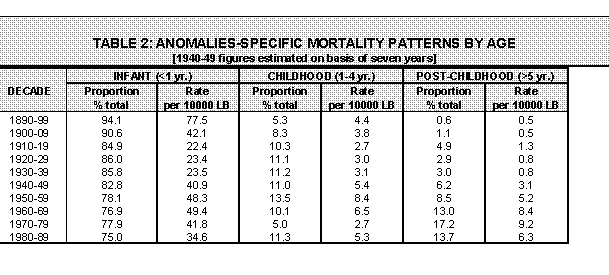
The published mortality figures fail to give any indication as to the contribution of congenital anomalies towards stillbirths. Information about the rates and cause of early neonatal deaths has only been available since 1950. The specific early mortality rates from congenital anomalies appears to have maintained a steady trend throughout the period, even though the overall early neonatal death rate decreased progressively. The anomalies-caused early neonatal death rate in 1951-55 was 17.9 per 10,000 births, 21.0 in 1961-65, 22.2 in 1971-75, 20.2 in 1981-85, and 15.7 in 1990-94. The slight rise noted in the 1960s is most likely due to better diagnosis and registration of cause of death, rather than a true increase in lethal anomalies [9]. Congenital malformations have long been identified to be important contributors towards perinatal deaths. In a study of 243 perinatal deaths occurring in Malta (with a bias towards early neonatal deaths 73.3%) undergoing post-mortem during the period 1957-66, congenital malformations were identified as being the second commonest cause of perinatal loss accounting for 15.2% of deaths. Congenital anomalies accounted for 16.8% of all perinatal deaths during the period 1979-82 and 23.5% during 1983-86 [10].
Congenital malformations have consistently been reported to be responsible for 10-15% of perinatal deaths in males and for 12-28% in females, with an overall specific mortality rate of 30-80 per 10,000 live births for girls and 32-58 per 10,000 births for boys. The higher death rate among females - especially pronounced for late fetal mortality - is contrary to what is observed for the vast majority of causes of perinatal death. The general incidence of congenital malformations detected in the perinatal period, whether in the liveborn infant or in the dead fetus, varies from 1.3-2.0%. Since it is generally admitted that only one out of every two or three malformations is recognised during this period, the overall incidence can be estimated at 3-5% [11]. There are wide variations between countries in the incidence and in types of malformations. The average prevalence in the 18 EUROCAT registries is 23.2 per 1000 births with variations from 12.3 in West Flanders to 32.2 in Glasgow. In Hungary, where there is a long-standing and comprehensive recording system, the prevalence is very much higher at 58.2 per 1000 deliveries. Such variations among registries, and even within the same registry over time, is partly due to completeness in ascertainment and to the adoption of differing criteria of inclusion with regards to the minor abnormalities. Regional differences may also be due to actual differences in the incidence of congenital anomalies. Thus a very high incidence of neural tube anomalies (anencephalia, spina bifida, hydrocephalus: 10.55 per 1000 births) has been observed in Northern Ireland (Belfast). By way of comparison, the incidence of these conditions was 1.5 per 1000 in Yugoslavia and 1.9 per 1000 in Czechoslovakia. On the other hand, the incidence of congenital heart disease in three times as high in Spain (Madrid) as in Belfast [12].
The overall incidence of congenital anomalies in Malta during 1983-91 has been estimated at 190 per 10,000 total births. The stillbirth rate from congenital anomalies amounted to 9.1 per 10,000 total births, while the early neonatal death rate from malformations amounted to 18.6 per 10,000 total births. During the same period 1983-91, a total of 163 post-perinatal deaths were registered as being caused by congenital anomalies, approximating a specific mortality rate of 33.0 per 10,000 total births. These figures suggest that approximately a third of infants with congenital anomalies still die from their disorder mainly during the perinatal period. The larger proportion of these deaths throughout the years were caused by congenital cardiovascular lesions, with the second commoner group of malformations being abnormalities of the central nervous system including hydrocephalus and spina bifida [13].
Congenital heart disease is one of the most frequent of
all congenital
anomalies and constitutes an important problem from the public health
point
of view. Advances in the management of these individuals should be
reflected
by positive changes in the cause-specific mortality rates. Congenital
heart
disease as a specific cause of death was first reported in the Maltese
Islands only in 1911. In the decade 1911-1920 congenital heart disease
and other cardiovascular anomalies accounted for 30.6% of all deaths
caused
by malformations with a mean specific mortality rate of 2.34 per
100,000
population. There appeared to have been a gradual rise in specific
mortality
rates throughout the first half of the century, possibly from an
increasing
awareness of the condition by general practitioners (Figure
2).

The rate increased in the subsequent decades to a mean
of 4.36
per 100,000 population in 1921-30 and 4.43 in 1931-40. It reached a
maximum
rate in the post-Second World War period 1951-60 when a mean rate of
7.65
per 100,000 population was reported (Table 3).
After the 1950s, the annual specific mortality rates for congenital
cardiovascular
disease show a definite progressive decrease in mortality from this
disorder
reaching mean values of 2.38 per 100,000 in 1981-90 [14].
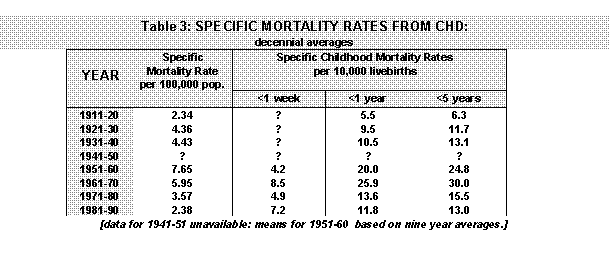
The specific mortality rates can be further analysed by patient age at death. The majority of deaths from CHD appear to occur in the first year of life. Thus during the decades 1911-20 and 1961-70 the proportion of infant deaths from congenital heart disease amounted to 82.1% and 71.8% respectively. These rates were maintained in the 1980s (79.0%). The specific infant (<1 year) mortality rate rose from 5.5 per 10,000 livebirths in 1911-20 to the 25.9 per 10,000 births in 1961-70. This rise reflects the increased awareness and diagnosis of the disorder by medical practitioners. The specific infant mortality subsequently fell to the 11.8 figure of 1981-90 reflecting an overall better survival. The specific childhood (<5 years) mortality rates followed similar patterns. The early neonatal (<1 week) mortality figures, available only after 1951, suggests that these rates have been little affected by the medical and surgical advances of these last decades (Table 3) [15].
The published data fails to identify the number of stillbirths caused by congenital cardiovascular disease. A review of the stillbirths occurring in Malta during the period 1981-85 suggests an annual cause-specific stillbirth rate of about 2 per 10,000 total births [16]. This suggests that the stillbirth and childhood mortality caused by CHD in the 1980s approximated 15 per 10,000 births The overall incidence of cardiovascular anomalies in Malta during 1983-91 has been estimated at 25.7 per 10,000 total births, 88% of which were recorded in live births. This prevalence rate is much lower than that recorded in most EUROCAT Centres where the mean prevalence at birth is 47.2 per 10,000 births, possibly because the Maltese rate excludes those cases of heart murmurs diagnosed on later examination [17]. It thus appears that approximately a half of infants born with CHD still die from their disorder. It is hoped that further improvement of care over the coming years will continue to diminish the mortality of this group of congenital defects.
The specific mortality rates for CHD have shown a
definite decline
in the overall mortality from CHD over the past five decades. This
decline
which appears to have started in the 1950s does not yet show any signs
of levelling off. A similar decline in specific mortality rates from
cardiovascular
anomalies has been reported in other European countries. Thus the mean
specific mortality rate from cardiovascular abnormalities in Europe has
fallen from about 4.3 per 100,000 population in the late 1960s to 1.9
per
100,000 population in the early 1990s. The majority of these deaths
have
been infant deaths (Table 4) [18].
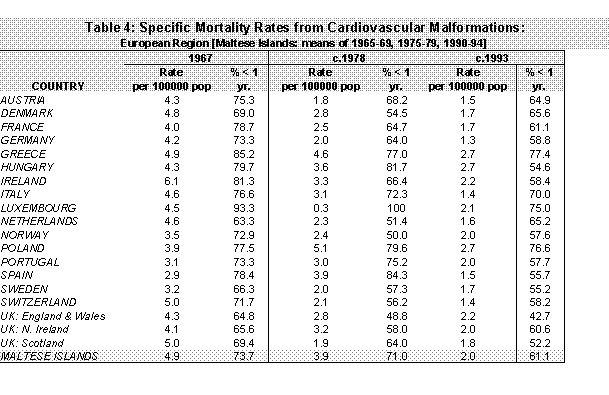
The decline in mortality rates has been the result of a number of factors. There has been in recent decades improved local management of these patients including the availability of more and better trained paediatricians and physicians with an interest in CHD, and better organised facilities for referral for assessment, investigation and surgery [19]. The improved local management followed the world-wide improvement of care of CHD patients, particularly in the surgical field, which has occurred since the 1950s [20]. World-wide surgical milestones in the management of CHD include the ligation of the patent ductus arteriosus (1939), the surgical subclavian artery to right pulmonary artery shunt to increase pulmonary flow (1945), the hypothermic closure of secundum ASD (1953), and the use of total cardiopulmonary bypass for closure of secundum ASD (1953) [21]. On the local field, the first patent ductus arteriosus closure was performed in Malta by Prof. P.P. Debono in 1947, while the first "blue baby" was sent to the UK for operation in 1950. After this patients with CHD were regularly reviewed by visiting British cardiologists and when necessary transferred to the UK for further investigations and surgery. A full-blown local programme of cardiac surgery in children, including open heart surgery, was initiated by a visiting team from the Hospital for Sick Children (London) in 1989 [22]. The world-wide surgical advances in the management of CHD were further augmented by the increasing availability and use of drugs in the alleviation of heart failure and other problems associated with congenital heart disease. The decreasing specific mortality figures from CHD in Malta may also reflect a decreasing incidence of the disorder, initiated with the introduction of rubella vaccination in the 1970s. Rubella vaccination decreases the number of infants born with congenital rubella syndrome which is strongly associated with CHD [23].
The mortality trends from Central Nervous System
Abnormalities show
a different pattern to that described for congenital vascular system
abnormalities.
Central nervous system abnormalities, mainly the neural tube defects
hydrocephalus
and spina bifida, have featured in mortality reports since the
mid-nineteenth
century. Thus in 1873 the thirteen cases of congenital malformations
deaths
reported were neural tube defects, this reflecting trends in
certification
with the exclusion of other malformations as causes of death. This
trend
in reporting was maintained throughout the 1880s. Other congenital
malformations
started to be more readily diagnosed and certified in the mid-1890s. In
1896 only three cases of deaths associated with neural tube defects
were
reported, accounting for only 3.3% of deaths caused by congenital
anomalies.
In the decade 1901-1910 neural tube defects and other central nervous
system
anomalies accounted for 23.4% of all deaths caused by malformations
with
a mean specific mortality rate of 3.7 per 100,000 population. In the
subsequent
two decades the specific mortality rate apparently fluctuating around a
mean value of 1.5 per 100,000 population (Figure
2) (Table 5). The rate rose in
the period (1931-40) to 2.6 per 100,000 population, a rise that was
maintained
through the 1951-60 period at 3.5 per 100,000 population. In the last
three
decades, the rate fluctuated around a mean of 1.3 per 100,000
population,
possibly showing a slight rise in mortality rates (Table
5). This rise is probably due to a greater proportion of infants
surviving the antenatal and intrapartum period because of more
intensive
antenatal supervision and aggressive intrapartum management, only to
die
after birth. There is at present in Malta no provisions for active
prenatal
diagnosis of neural tube defects [24].
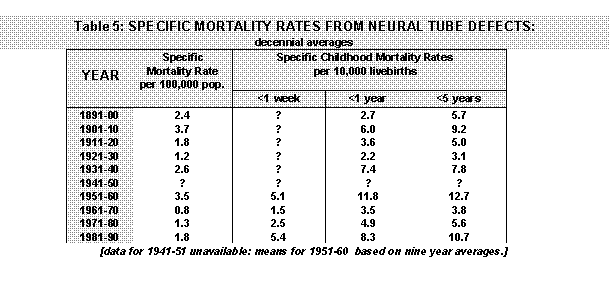
The majority of deaths from CNS anomalies appear to occur in the first year of life. Thus during the decades 1901-10 and 1961-70 the proportion of infant deaths from congenital CNS disease amounted to 23.4% and 25.9% respectively. These rates were maintained in the 1980s (26.3%). After falling in the first decade of the century, the specific infant (<1 year) mortality rate rose from 3.6 per 10,000 livebirths in 1911-20 to the 11.8 per 10,000 births in 1951-60. The specific infant mortality subsequently fell to the 3.5 figure of 1961-70 rising to the 8.3 figure of the last decade 1981-90. The fluctuations in the last decades suggest that there has been little improvement in the management of this condition. The specific childhood (<5 years) mortality rates followed similar patterns. The early neonatal (<1 week) mortality figures, available only after 1951, suggests that these rates have been little affected by the medical and surgical advances of these last decades (Table 5) [25].
The published data fails to identify the number of stillbirths caused by congenital neural tube defects. A review of the stillbirths occurring in Malta during the period 1981-85 suggests an annual cause-specific stillbirth rate of about 5.5 per 10,000 total births [26]. This suggests that the stillbirth and childhood mortality caused by CNS disease in the 1980s approximated 16.2 per 10,000 births The overall incidence of CNS defects in Malta during 1983-91 has been estimated at 23 per 10,000 total births, 48% of which were neural tube defects. The neural tube defect prevalence rate in the Maltese islands is significantly higher than that recorded in most EUROCAT Centres mainly because of a higher hydrocephalus rate [27]. It thus appears that approximately 70% of infants born with CNS anomalies still die from their disorder.
The specific mortality rates for CNS anomalies have
shown a slight
rise in the overall mortality from CNS disease over the last decades.
In
contrast a slight decrease in specific mortality rates from CNS
anomalies
has been reported in other European countries. Thus the mean specific
mortality
rate from CNS abnormalities in Europe has fallen from about 0.9 per
100,000
population in the late 1960s to 0.3 per 100,000 population in the early
1990s. The majority of these deaths have been infant deaths (Table
6) [28].
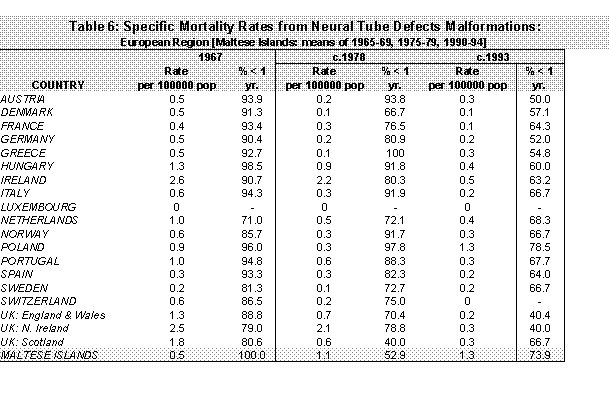
The absence of any significant improvement in the
mortality rates
from central nervous system abnormalities is not surprising considering
the poor prognosis of these individuals in spite of developments in
surgical
therapy. The majority of central nervous system malformations fall in
the
categories of either hydrocephalus or spina bifida. These two CNS
anomalies
are theoratically correctable by surgery, but unfortunately this
remains
an elusive goal. The history of the treatment of hydrocephalus is an
example
of slow and painstaking progress. The modern concepts of hydrocephalus
were established by Walter Edward Dandy and Kenneth Blackfan in studies
reported in 1913. Based on these studies, Dandy subsequently developed
the operation of choriod plexectomy, third ventriculostomy, and
catheterization
of the aqueduct of Sylvius. Many other individual subsequently
developed
operations to shunt cerebrospinal fluid from the ventricles or
subarachnoid
space into the subgaleal, subdural, subarachnoid, or spinal epidural
space;
or the pleural, peritoneal cavity, or other sites. However shunt
occlusion
and infection proved to be two major obstacles. In 1939, Arne
Torkildsen
of Oslo introduced his ventriculocisternostomy, but the indications for
this type of surgery were limited. It was only in the 1950s that
reasonably
reliable ventriculovenous shunting techniques were introduced by Frank
Nulsen and Eugene Spitz in 1952 and Robert Pudenz and his colleagues in
1957. The key of this success of these operations was the development
of
functional one-way valves constructed of inert material. The Holter
valve
was developed in 1956 in response to an urgent personal need. The
infant
son of an industrial technician, John Holter, was being treated for
hydrocephalus
by Dr. Spitz, as a result of which Holter was stimulated to turn his
inventive
talents to designing a valve that permitted ventriculojugular shunting.
This initial Holter valve and its subsequent modifications has
progressively
improved the outlook for patients with hydrocephalus. In spite of these
advances ventriculoperitoneal shunts retain high short and long-term
complication
rates which necessitate a very vigilant follow-up of operated
individuals.
The surgical closure of spina bifida has also been fraught with
disappointment.
The initial enthusiasm of the Sheffield physicians who in 1959 began a
program of immediate closure in all neonates with NTD has now waned,
after
re-examination of the survival of these infants showed that only 7% had
less than a grossly crippling disability. A selective policy towards
surgery
has been advocated. The arguments for and against a selective treatment
policy for infants with spina bifida continues to be examined [29].
Notes
1 P.H.D.: Return of Deaths in Malta and Gozo. Malta Government Gazette, 1872-1896, fortnightly reports published by the Public Health Department; D.O.H.: Annual Reports on the Health Conditions of the Maltese Islands and on the work of the Medical and Health Department for the years 1896-1970. Annual publications published as supplements of the Malta Government Gazette or as Departmental publications; C.O.S.: Demographic Review of the Maltese Islands 1960-1994. Central Office of Statistics: Malta, 1961-1996. Annual publications.
2 P.H.D.: ibid
3 P.H.D.: ibid ; D.O.H.: op. cit.
4 D.O.H.: ibid
5. C. Savona-Ventura: Reproductive performance on the Maltese Islands during the First World War. J.R. Army Med Corps, 1995, 141:107-111; C. Savona-Ventura: Reproductive performance on the Maltese Islands during the Second World War. Medical History, 1990, 34:164-177; D.O.H.: ibid ; P. Vassallo-Agius: An outline of the development of paediatrics in Malta in the twentieth century. Paediatric Update (ed. P. Vassallo Agius, R. Parascandolo, C. Vella), University Press, Malta, 1991, p.110-126
6 D.O.H.: ibid ; C.O.S.: op. cit.
7 W.H.O.: World Health Statistics Annual. WHO: Geneva, 1967-1995, Annual publications
8 D.O.H.: op. cit.; C.O.S.: op. cit.
9 E.S. Grech, C. Savona-Ventura: Analysis of perinatal deaths occurring in Malta. Mortalita e Morbosita Perinatale (L. Zecchella, A. Santoro, M. Valenta, eds.). Monduzzi, Bologna, 1986, p.105-114; C.O.S.: op. cit.
10 H.M. Sultana, F. Calleja: Perinatal mortality - necropsy findings 1957-1966. St. Luke's Hospital Gazette, 2(1):38-41; E.S. Grech, C. Savona-Ventura: ibid; E.S. Grech, C. Savona-Ventura: The Obstetric and Gynaecological Service in the Maltese Islands - 1987. Malta, 1988, p.54
11 N.R. Butler, D.G. Bonham: Perinatal mortality, first report of the 1958 British Perinatal Mortality Survey. Livingstone: Edinburgh, 1963; N.R. Butler, E.D. Alberman: Perinatal problems, second report of the 1958 British Perinatal Mortality Survey. Livingstone: Edinburgh, 1969; T. McKeown, R.G. Record: Ciba Foundation Symposium on Congenital Malformations (E.N. Wolstenholme, C.M. O'Connor, eds.). Churchill: London, 1960; W.H.O.: The Prevention of perinatal morbidity and mortality. Report on a Seminar. WHO: Geneva, 1972, p.23-26
12 Eurocat Report 4. Surveillance of Congenital Anomalies Years 1980-1988. EUROCAT Central Registry: Brussels, 1990; A. Cuschieri: A survey of Congenital Anomalies in Malta. Collected Papers published on the occasion of the Collegium Melitense Quatercentenary Celebrations (1592-1992) (R. Ellul-Micallef, S. Fiorini, eds.). Malta: University of Malta, 1993, p.221-244; W.H.O.: ibid
13 A. Cuschieri, 1993: ibid; C.O.S.: ibid
14 D.O.H.: op. cit.; C.O.S.: ibid
15 D.O.H.: ibid ; C.O.S.: ibid
16 The stillbirths associated with specific congenital abnormalities for the period 1981-1985 were identified from the Minutes of the Perinatal Mortality Meetings of the Department of Obstetrics and Gynaecology coupled with the postmortem reports issued by the Department of Pathology during the period. During this five year period, there were a total of 253 stillbirths reported from the Maltese Islands. Of these 249 (98.4%) occurred in Karin Grech Hospital. The postmortem rate for stillbirths in the hospital during this period was high varying from 76% to 91% making the data representative of the total Maltese population. Congenital malformations were identified in 29 (11.5%) cases, giving an annual cause-specific stillbirth rate of about 10.3 per 10,000 total births. A total of six deaths with associated congenital heart disease were identified.
17 A. Cuschieri,1993: op. cit.; P. De Wals, H. Dolk, J.A.C. Weatherall , et al: Prevalence of congenital anomalies in 19 EUROCAT countries, 1979-1982. In: Registration of congenital anomalies in Eurocat Centres 1979-1983 (P. De Wals, J.A.C. Weatherall, M.F. Lechat, eds). Cabay: Belgium, 1985, p.146-202
18 W.H.O.: op. cit.
19 M. Galea Curmi: The Hospitalisation of the Maltese Patient Abroad. [Thesis] University of Malta, 1982
20 W.J. Rashkind: Paediatric Cardiology: A brief historical Perspective. Paediatric cardiology, 1979, 1:63-71
21 R.E. Gross, J.P. Hubbard: Surgical ligatiuon of a patent ductuc arteriosus: report of first successful case. JAMA, 1939, 112:729-31; A. Blalock, H.B. Taussig: The surgical treatment of malformations of the heart in which there is pulmonary stenosis or pulmonary atresis. JAMA, 1945, 128:189-202; F.J. Lewis, M. Taufic: Closure of atrial septal defect with aid of hypothermia: experimental accomplishments and the report of one successful case. Surgery, 1953, 33:52-9; J.H. Gibbon: Application of a mechanical heart and lung apparatus to cardiac surgery. Minn Med, 1954, 37:171-80
22 Vassallo Agius P: op. cit.
23 C. Swan, A. Tostevin, B. Moore, H. Mayo, G.H.D. Black: Congenital defects in infants following infectious disease during pregnancy, with special reference to relationship between German measles and cataract, deaf-mutism, heart disease, and microcephaly, and to period of pregnancy in which occurrence of rubella is followed by congenital abnormalities. Med J Aust, 1943, 2:201
24 D.O.H.: op. cit.; C.O.S.: op. cit.
25 D.O.H.: ibid ; C.O.S.: ibid
26 Minutes ..... : op. cit. Sixteen cases of stillbirths were identified to have central nervous system abnormalities.
27 A. Cuschieri,1993: op. cit.; De Wals P., Dolk H., Weatherall JAC, et al, 1985: op. cit.
28 W.H.O.: op. cit.
<>29 R.H. Wilkins, S.S. Rengachary, eds.: Neurosurgery. McGraw-Hill Co., New York, 1985, p.1-20, 2140-2150
It would be appreciated if source acknowledgement is made whenever any material is used from this source.
Citation: C. Savona-Ventura: The Health of the Maltese Population. Internet Home Page [http://www.oocities.org/savona.geo/index.html], 1996